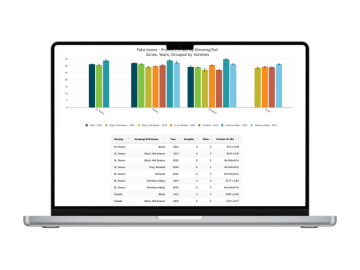
New Research Tackling Root Rot Head On
Activity 7 - Pulse Science Cluster Update
Jul 01, 2025

Principal Investigator — Dr. Syama Chatterton, pulse pathology research scientist with Agriculture and Agri-Food Canada Lethbridge Research and Development Centre
Root rot in peas and lentils poses a significant threat to production and rotations across the Canadian Prairies. Addressing this challenge on behalf of pulse growers requires a multifaceted approach. Dr. Syama Chatterton and her colleagues are adopting an integrative strategy— combining breeding, biology, and agronomy—to combat the disease and boost yields for farmers. The team is building upon previous cluster research by initiating these new activities in genetics, biology, and agronomy.
The Pulse Science Cluster (the Cluster) is a cost-shared initiative under the federal government’s Sustainable Canadian Agricultural Partnership. Through the Cluster, research is funded that aims to advance the profitability and resilience of pulse growers by addressing key challenges in pulse production and developing new variety options.
“Effective management strategies will require a multi-pronged approach based on a foundation of soil testing, crop rotation, and the deployment of partially-resistant cultivars, coupled with the best pest management practices to support the longevity of resistance - all functioning within a dynamic feedback loop,” says Dr. Chatterton.
Breeding Genetic Resistance Traits
Developing a gene-editing platform in peas and lentils will help evaluate what genes may act as susceptibility or resistance factors for root rot development. In Lethbridge, Alta. Dr. Stacy Singer is working to create novel pea and lentil germplasm with enhanced genetic variability to explore innovative resistance traits. An effective pea-transformation protocol has been established. Gene edited plants are growing in the greenhouse, and a CRISPR/Cas-based gene-editing platform for peas is in development.
The previously published method for genetically improving lentils hasn’t been working as expected on the tested varieties. While the cells are growing (forming callus), they’re not developing into new plantlets (shoots). Researchers are currently troubleshooting different methods and lentil varieties to achieve successful genetic transformation. “We’ve successfully optimized a pea-transformation protocol and are in the final stages of developing an efficient lentil protocol,” adds Dr. Chatterton.
Haplo-genomic markers identify groups of alleles (gene variants) inherited from a single parent, helping researchers trace lineage, understand genetic diversity, and select for genetic combinations that contribute to disease resistance. At the National Research Centre in Saskatoon Dr. Wentao Zhang is developing consistent and cost-effective haplo-genomic markers for rapid screening of root rot resistance traits in peas.
Assessing many pea lines by creating a genetic map will allow for more precise breeding targets and markers for selecting resistance traits from large populations. A high-resolution database has been constructed, integrating 110 million high-quality genetic variations identified from the reference sequence and resequencing 300 pea lines from root rot genetic resistance resources.
“This database enables the development of high-resolution genetic maps achieving an accuracy of 99.6 per cent,” says Dr. Chatterton. “Additionally, it has facilitated the identification of novel resistance genes within our established pea root rot genetic resources. “
Biology
By studying and harnessing the microbial communities in soils that naturally suppress plant diseases, researchers can unlock the potential for biocontrol strategies. Microbiome characteristics from soils were meticulously collected from 60 fields across Alberta, Saskatchewan and Manitoba. At the AAFC Lethbridge Research and Development Center, Dr. Monika Gorzelak has spearheaded the compilation of the first comprehensive set of soil- and pea-rhizosphere metagenomic data—genetic insights obtained from microbial communities in the soil region surrounding plant roots.
Additionally, she’s creating an extensive library of mycorrhizal fungi, which form symbiotic relationships with plant roots. These fungi will be matched to various pulse crops and tested for their effectiveness against plant diseases.
Dr. Chatterton is leading greenhouse trials in sterile soil using an Aphanomyces euteiches isolate, a pathogen responsible for root rot, to compare infection dynamics in peas and lentils. Understanding the concentration thresholds of Aphanomyces euteiches oospores, the soilborne inoculum that initiates infection, under different soil conditions can significantly enhance root rot prediction and diagnostics. Although the lentil isolate was slightly less aggressive than the pea isolate, the trials revealed both required the same inoculum level of 100 oospores per gram of soil-to-cause disease.
Previously undetermined for lentils, these findings confirm the inoculum threshold is consistent with that of peas. Upcoming greenhouse trials will further investigate lentil and pea disease dynamics and inoculum thresholds under varying moisture and temperature conditions.
Agronomy
Collecting long-term information on root rot incidence and severity across the Prairie provinces increases understanding of risk factors related to root rot development. In 2023 and 2024, provincial partners collaborated to perform field surveys in Alberta, Saskatchewan, and Manitoba. Roots were tested for various pathogens, and data is matched with soil zones and precipitation to determine long-term trends. The results from the 2023 samples are shown in Table 1.
Table 1: 2023 Pathogen Sample Testing Results
Number of Fields | Type of Crop | Positive for Aphanomyces euteiches | Positive for Fusarium solani | |
Alberta | 123 | Pea | 53% | 75% |
Saskatchewan | 39 | Lentil | 46% | 61% |
Saskatchewan | 31 | Pea | 58% | 94% |
Fusarium avenaceum prevalence was lower in 2023, ranging from 20 to 35 per cent positive fields, likely due to the drier conditions experienced. | ||||
Root samples from 2024 are being analyzed from 100 pea fields in Alberta, 40 lentil fields and 40 pea fields in Saskatchewan, and 50 pea fields in Manitoba.
In 2024, Dr. Jeff Schoenau at the University of Saskatchewan led field trials examining the efficacy of copper-sulphate and mono-ammonium-phosphate treatments across seven sites in Saskatchewan, Alberta and Manitoba. Preliminary data from the AAFC Swift Current research site suggests copper sulphate application may slightly reduce root rot. Building on this work, Dr. Michelle Hubbard at AAFC Swift Current and Dr. Chris Yost at the University of Regina will evaluate biocontrol agents in 2025 field trials, leveraging insights from previously funded research.
Conclusion
This research activity addresses all the essential aspects required for an integrated and practical management approach using genetics, biology and agronomy to combat pea and lentil root rot. Traditional products and practices, such as seed treatments, chemical applications, tillage, intercropping, liming, and crop rotations, have not significantly reduced disease severity or improved yields.
Dr. Chatterton and her dedicated team are conducting rigorous research across fields, greenhouses, and laboratories in Western Canada to prevent and mitigate root rot damage in peas and lentils. Their integrative approach holds great promise, ensuring the long-term sustainability and productivity of pea and lentil crops for western Canadian farmers.
“Root rot of peas and lentils has plagued pulse growers for over 10 years,” says Dr. Chatterton. “Research is a slow process, but with projects like these, we make the incremental changes needed to devise multi-pronged solutions. “
Sign Up for Our Pulse Insider Newsletter
Our bi-monthly newsletter provides growers with timely, quick reads on the latest industry news and Pulse Canada’s work around the world.
Pulse Canada is the national association of growers, traders and processors of Canadian pulses, also known as lentils, dry peas, beans and chickpeas. Pulses are an essential part of a healthy and sustainable diet. Pulses and pulse ingredients can help food manufacturers improve the nutritional and functional quality of food products.


